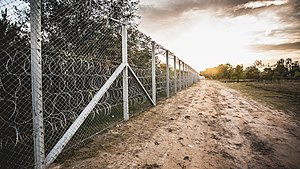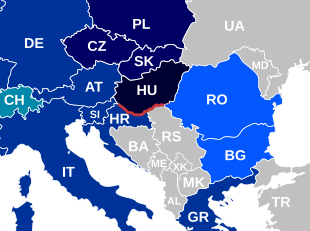Hungarian border barrier
| Hungarian border barrier | |||||||||||||
|---|---|---|---|---|---|---|---|---|---|---|---|---|---|
| Déli határzár | |||||||||||||

The border barrier at the Serbo-Hungarian border
|
|||||||||||||

Border barrier in operation or natural barrier: river (Serbian and Croatian border)
Planned border barrier (Romanian border)
|
|||||||||||||
| Type | Border barrier | ||||||||||||
| Height | 4 metres (13 ft) | ||||||||||||
| Length | 523 kilometres (325 mi) | ||||||||||||
| Site information | |||||||||||||
| Owner |
|
||||||||||||
| Operator |
|
||||||||||||
| Controlled by |
In cooperation with the Visegrád Four: |
||||||||||||
| Site history | |||||||||||||
| Built | 2015 | ||||||||||||
| Built by |
|
||||||||||||
| Materials | Concertina wire | ||||||||||||
| Events | European migrant crisis | ||||||||||||
In 2015, Hungary built a border barrier on its border with Serbia and Croatia. The fence was constructed during the European migrant crisis (see timeline), with the aim to ensure border security by preventing immigrants from entering illegally, and enabling the option to enter through official checkpoints and claim asylum in Hungary in accordance with international and European law. The number of illegal entries to Hungary declined greatly after the barrier was finished.
Following an increased influx of migrants into the Schengen Area despite the Dublin Regulation, Hungary stated that the EU was "too slow to act", and started construction of the barrier in June 2015. According to BBC News, "many of the migrants currently in Hungary have been refusing to register there, in order to continue their journeys to Germany before seeking asylum", thus refusing to comply with European law. Hungarian Prime Minister Viktor Orbán commented: "Our job is only to register them". The barrier was completed in September. Later, Hungary constructed barriers on minor sections of the Croatian border that are not separated by the Drava river.
The border between Hungary and Serbia is 175 kilometres (109 mi) long. In June 2015 the Hungarian cabinet approved construction of a 4 metres (13 ft) high barrier. Construction of the barrier began in early July. As of early August, Hungary was on track to complete the fence by the end of the year. The fence, which features concertina wire, is being built by contractors and a deployment of 900 soldiers at a cost of 30 billion forints ($106 million) for the 4-meter (13-foot) fence and the construction of two camps to house asylum applicants.
By mid-August the barrier was taking shape as a double security fence. There is a hastily constructed outer fence made up of three rows of razor wire, scheduled to be complete by the end of August 2015. Inside that, there is a sturdier barrier 3.5 meters (11.5 feet) tall. The slow pace of the fence's construction led to the resignation of Csaba Hende, the Hungarian defence minister, on 7 September 2015. The first stage of construction was started on July 13 and it was completed and the border sealed by Monday, 14 September.
...
Wikipedia
